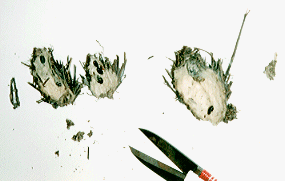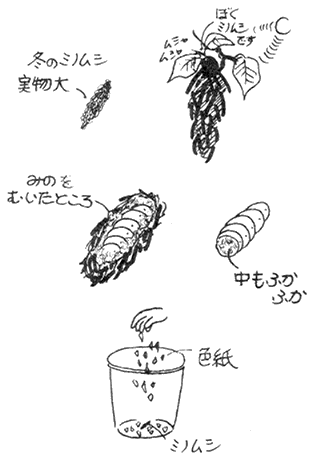
Internet version [Naruhodo no Mori] Vol.25
by Yumiko Mori

Vol. 25 January 15th, 1997
Bagworm
Home science experiments for mothers of elementary school children
Mom: "I want to ask you a favor."
Dad: "What do you want me to do?"
Mom: " Could you take the leaf from this bagworm?"
Dad: "You should be able to do it yourself."
Mom: " I hate bugs. I don't want touch them.
I can't do it!"

Dad: "Well, it seems like I have to do this."
Reluctantly Dad started peeling off the leaf from the bagworm.
Make a small opening using a pair of scissors.
Dad: "This is quite tight. A little difficult to open up.
Look! I found them!"
Mom: "Oh, no!"
Mom screams as she sees what is inside the bag.
Wondering why Mom screamed, Tae came over.
Tae: "What? Grotesque! What are these?"
Mom: "Bagworm!"
Tae: "They exactly look like 'alien'."
Mom: "That's right. Completely black. They are repulsive!"
Dad: "There is a 'mattress' in the 'bag'. Look!"
Mom: "Yes, I can see. Really clever!"
We pick the worms out from the bag and place them
on color paper pieces.
We place another color paper pieces over the worms.
Tae: "I hope we will see them making new bags from these papers."
Mom: "I hope they make pretty bags"
Tae: "Dad was very nice. He helped us to peel the bag off."
Mom: "That's true. I am so glad I am married to Dad."
[Bagworm]
Bagworms are caterpillars of bag-weaving moths.
There are about 20 species in Japan.
In July male bagworms grow into pupa in the bags
and then emerge as adult moths.
Adult males fly out from the bags
and eventually mate with females before dying.
Then females lay eggs in the bags before dying.
Females never come out of the bags
but spend their whole lives in the bags.
Therefore we have little chance to find the moth parents.

Materials
- Bagworms
- A pair of scissors
(preferably sharp scissors with pointed ends)
- A mirror, a sheet of black paper or a black trash bag
For the observation of bag formation
- A clear plastic cup
- Color papers
(alternatively wool wastes or waste threads)

Observation of bagworms
In winter you can only observe what are inside bags.
In summer you can observe the bag formation for 2 days or so.
- Find bagworms.
You find on tree branches.
In winter worms are small (~1 cm long),
but in summer they can be as large as 3~4 cm long.
When I found big ones inside leaves in winter,
all of those turned out to be shedding.
You may take a branch off from a tree, take it home,
and watch them in your room.
Worms eat leaves. But they do not eat in winter.
- Peel off 'bag' from a bagworm.
(Worms are very tiny in winter.)
You can use a pair of scissors
but be careful not to injure worms.
Inspect 'bags'.
- In spring bagworms become more active.
Observe how they build 'bags'.
Cut color papers into small pieces
and sprinkle them into a clear plastic cup.
The size of paper pieces should be close to
that of tree twigs the worms used for their bags.
Lay naked worms in the cup.
Sprinkle more paper pieces over the worms.
Check sometimes how much 'bags' the worms are building.
* It's easier to memorize where bagworms are during winter.
You usually find small child worms
next to a big adult worm.
* You may find a brownish pupa in an empty 'bag'.
* My book says that males become from gray color to black color and
that females become reddish color to light yellow color.
I saw only black ones in the wild.
* According to my mother,
many years ago there were wallets made from bagworms' bags.
Something extra
Since I did the 'bag formation' experiment in summer,
I wanted to see bagworms again.
When most of leaves fell off from trees,
we went to search for the worms.
Small bagworms were difficult to find.
I kept looking up trees so long that I felt neck pain.
I couldn't find bagworms but made other discovery such as praying mantis eggs
and cocoon of a moth, Limacodidae.
I've never seen these other than in books. With these extras,
I think that time I spent for searching bagworms was very much worthy.
| Author | Yumiko Mori (Zushi, Kanagawa, Japan) |
|---|
| Illustration | Mitsue Ogata |
|---|
| Translator | Akira Ishihara |
|---|
| HTML format | Muneo Kume |
|---|
Copyright © 1997 Rika no Heya & Yumiko Mori









